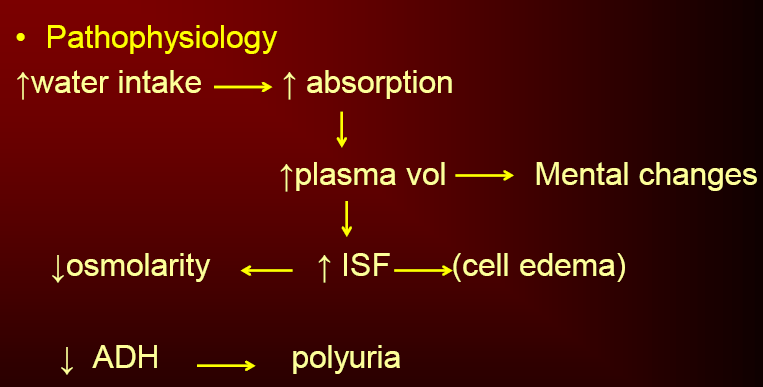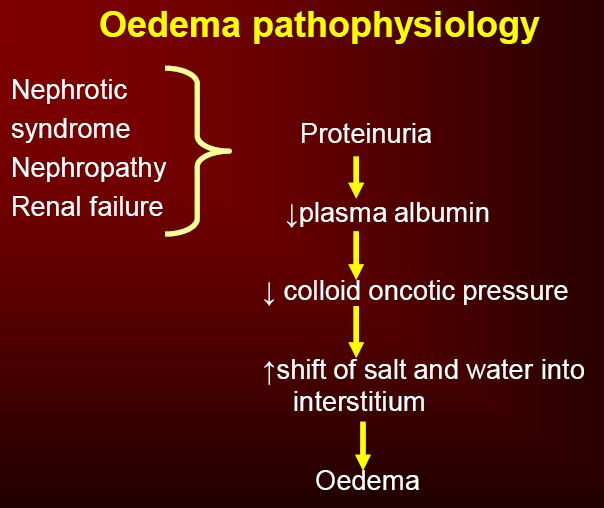The body fluid compartments in the body can be divided into:
1.Extracellular fluid compartment
2. Intracellular fluid compartment
Distribution of compartments:
•Average 70 kg adult human – 42 liters
•60% of total body weight
–ICF contains 28L
–ECF contains 14 L
interstitial fluid is 11 litres.
plasma is 3 litres.
Total body water depends upon:
- Age
- Sex
- Degree of obesity
With Increasing Age
•Percentage of total weight that is water decreases
•Aging – associated with increased percentage of body water that is fat
•Fat – decreases percentage of water in body
Women – More body fat than men
•Contain slightly less water than men in proportion to their weight
Body water
•Importance/significance –Solvent
–Cations
–Anions
–Intracellular medium
–Water deprivation leads to DEATH
Physiological variation
•Sex
–Male (60%) 54 – 70%
–Female (50%) 45 – 60%
•Age
–More in children
–Gradual decrease
•Obesity
–Less body water
Water balance
•In health total body water is kept reasonably constant in spite of wide fluctuations in daily intake.
–Daily intake = Daily output • (20 ºC, No exercise)
Intracellular fluid Compartment
– 28 liters inside 75 trillion cells of body
Constitutes 40% of body weight
Composition of cell fluids – remarkably similar even in different animals ranging from most primitive micro-organisms to humans
•ICF of all different cells regarded as one large fluid compartment
Extracellular fluid compartment:
•All fluid outside cells
•14 liters in normal 70 kg adult •20% of body weight
Compartments of ECF
- Interstitial fluid
- Plasma
Interstitial Fluid
3/4th of ECF
•11 liters
PLASMA
•1/4th of ECF
•3 liters
Blood Volume
•Both Intracellular & Extracellular fluids are involved
•Separate fluid compartment –contained in a chamber of its own –circulatory system
•5 liters / 7% of body weight
Plasma – 60% of blood
•Red blood cells – 40%
•Vary depending upon
- Age
- Sex
- Weight etc
Water Balance
Daily Intake of Water
- Fluids Ingested (liquids/water in diet) – 2100 ml
- From metabolism – 200 ml
Net Intake = 2300 ml
Daily output of Water
- Insensible (skin) – 350 ml •
- Insensible (lungs) – 350 ml
- Sweat – 100 ml
- Feces – 100 ml
- Urine – 1400 ml
Net Output = 2300 ml
Water balance
•Water intake=water output
•Intake
–Determined by social considerations rather than physiological needs.
–Thirst safeguards fluid intake.
•Water loss
–Increased
•Exercise(3300 ml/day)
•Hot weather(6600 ml/day) •Pathological(4_8 L/day)
–Urinary volume —only variable that controls
Positive water balance
•Increased water intake than water loss
•CAUSES
–Infants
–Growing children
–Athletes
–Pregnancy
Negative water balance
•Decreased water intake than water loss
•CAUSES
–Fatty meal
–Diuretics use
–Dehydration—-Thirst
Measurement of different body fluid compartments;
Indicator Dilution Method
Depends upon law of conservation of mass.
Total mass of the indicator after distribution in the compartment is the same as the mass before distribution.
Indicator properties
•Disperses evenly throughout the compartment
•Disperses only in the compartment that is being measured
•Not metabolized or excreted
Indicators used:
1. Total Body Water
•Radioactive water (Tritium, 3H2O)
•Heavy water (Deuterium, 2H2O)
•Antipyrine
2. ECF Volume
•Inulin
•22Na
•125I-iothalamate thiosulfate
3. ICF Volume
ICF Vol = Total Body water – ECF Vol
4. Plasma Volume
•Evans Blue dye (T-1824)
•125I-albumin
5. Interstitial Fluid Volume
Interstitial Fluid vol = ECF vol – Plasma Vol
Osmotic equilibrium
•Maintained between ECF and ICF.
•Free flow of water through cell membrane.
•TBW – Final distribution determined by osmotic and hydrostatic forces
•Osmolality of body fluids-300 m osm /L
•Isotonicity, hypotonicity, hypertonicity
•Isotonic solutions
–0.9% NaCl
–5% Glucose
Abnormal states and changes in vol and osmolalities (ECF and ICF)
- Dehydration
- I / V infusions
- Fluid loss (Physiological,pathological) •Osmolalities do not change for longer duration after addition of a solution
There is excellent osmolality regulation
Water depletion / dehydration
•Causes
–Low intake
–Poor absorption
–Increased loss
•Diarrhoea
•Vomiting
•Cholera
Clinical features
- Thirst
- Dryness of mouth
- Dry loose skin
- Oliguria
- Sunken eyes
- Hypotention
- Delerium
- Haemoconcentration (↑ PCV )
Water Excess ( water toxicity)
•CAUSES
- Excessive intake
- Renal retention / dysfunctional nephrosis
- Nephrotic syndrome
- Liver damage _ hypoproteinemia
- Raised ADH
- Drugs e.g. narcotics
- Hypothyroidism
CLINICAL FEATURES
- Headache
- Nausea / vomiting
- Cramps
- Raised BP
- Polyuria
- Cardiac overload
- Haemodilution
Edema
–Accumulation of excessive fluid in body tissues
Types
–Intracellular
–Extracellular (more common)
Intracellular edema
Causes
- Depression of metabolic systems of tissues (cells)
- Lack of adequate nutrition
- Na+-K+ ATPase pump failure
- Inflammed tissues
Extracellular edema
•Pathophysiology
- Abnormal fluid leakage from blood capillaries
- Failure of lymphatic drainage system
•Causes
- Increased capillary pressure
- Decreased plasma proteins
- Increased capillary permeability
- Lymphatic blockage
Increased capillary pressure
•Excessive kidney retention of salt/water
- Acute / chronic kidney failure
- Mineralocorticoid excess
•High venous pressure/constriction
- Heart failure
- Venous obstruction
- Failure of venous valves
• ↓arteriolar resistance
- Excessive body heat
- Insufficient sympathetic nervous sys
- Vasodilator drugs
Decreased plasma proteins
- Loss of proteins in urine (nephrotic syndrome)
- Loss of protein from denuded skin
Burns
Wounds
- Failure to produce proteins
Liver disease
Malnutrition
Increased capillary permeability
- Immune reactions causing release of histamine/immune products
- Toxins
- Bacterial infection
- Vitamin C deficiency
- Blockage of lymph return
Cancer
Infections (filaria nematodes)
Surgery
- Congenital absence of lymphatic vessels
edema safety factors
§ Low compliance in negative ISF pressure range
§ Increased lymphatic flow
§ Protein wash out from ISF
 howMed Know Yourself
howMed Know Yourself




good for medicle and nursing .
very nice presntation
very good information for all heath sciences studies
very elaborate write up for me as medical student. Please can you explain how you arrive at 3L for plasma vol.
A concise and invaluable write up for tutors and students alike
Body fluids physiology is a done deal with this information. A complete guide to physiology of body fluids and electrolytes
very nice! Thanks alot.
concise but informative. Nice!
wow! great information concerning health. brief and precise. I have learned alot
very nice presentation